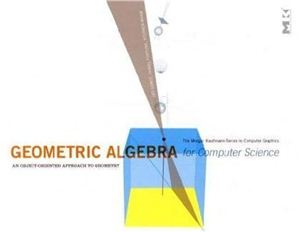Издательство Morgan Kaufmann, 2007, -622 pp.
Geometric algebra is a powerful and practical framework for the representation and solution of geometrical problems. We believe it to be eminently suitable to those subfields of computer science in which such issues occur: computer graphics, robotics, and computer vision. We wrote this book to explain the basic structure of geometric algebra, and to help the reader become a practical user. We employ various tools to get there: Explanations that are not more mathematical than we deem necessary, connecting
algebra and geometry at every step
A large number of interactive illustrations to get the object-oriented feeling of constructions that are dependent only on the geometric elements in them (rather than on coordinates)
Drills and structural exercises for almost every chapter
Detailed programming examples on elements of practical applications
An extensive section on the implementational aspects of geometric algebra (Part III of this book)
This is the first book on geometric algebra that has been written especially for the computer science audience. When reading it, you should remember that geometric algebra is fundamentally simple, and fundamentally simplifying. That simplicity will not always be clear; precisely because it is so fundamental, it does basic things in a slightly different way and in a different notation. This requires your full attention, notably in the beginning, when we only seem to go over familiar things in a perhaps irritatingly different manner. The pattes we uncover, and the coordinate-free way in which we encode them, will all pay off in the end in generally applicable quantitative geometrical operators and constructions.
We emphasize that this is not primarily a book on programming, and that the subtitle An Object-oriented Approach to Geometry should not be interpreted too literally. It is intended to convey that we finally achieve clean computational objects (in the sense of object-oriented programming) to correspond to the oriented elements and operators of geometry by identifying them with oriented objects of the algebra.
Why Geometric Algebra?
Part I Geometric Algebra
Spanning Oriented Subspaces
Metric Products of Subspaces
Linear Transformations of Intersection and Union of Subspaces
The Fundamental Product of Geometric Algebra
Orthogonal Transformations as Versors
Geometric Differentiation
Part II Models of Geometries
Modeling Geometries
The Vector Space Model: the Algebra of Directions
The Homogeneous Model
Applications of the Homogeneous Model
The Conformal Model: Operational Euclidean Geometry
New Primitives for Euclidean Geometry
Constructions in Euclidean Geometry
Conformal Operators
Operational Models for Geometries
Part III Implementing Geometric Algebra
Implementation Issues
Basis Blades and Operations
The Linear Products and Operations
Fundamental Algorithms for Nonlinear Products
Specializing the Structure for Efficiency
Using the Geometry in a Ray-Tracing Application
Part IV Appendices
A Metrics and Null Vectors
B Contractions and Other Inner Products
C Subspace Products Retrieved
D Common Equations
Geometric algebra is a powerful and practical framework for the representation and solution of geometrical problems. We believe it to be eminently suitable to those subfields of computer science in which such issues occur: computer graphics, robotics, and computer vision. We wrote this book to explain the basic structure of geometric algebra, and to help the reader become a practical user. We employ various tools to get there: Explanations that are not more mathematical than we deem necessary, connecting
algebra and geometry at every step
A large number of interactive illustrations to get the object-oriented feeling of constructions that are dependent only on the geometric elements in them (rather than on coordinates)
Drills and structural exercises for almost every chapter
Detailed programming examples on elements of practical applications
An extensive section on the implementational aspects of geometric algebra (Part III of this book)
This is the first book on geometric algebra that has been written especially for the computer science audience. When reading it, you should remember that geometric algebra is fundamentally simple, and fundamentally simplifying. That simplicity will not always be clear; precisely because it is so fundamental, it does basic things in a slightly different way and in a different notation. This requires your full attention, notably in the beginning, when we only seem to go over familiar things in a perhaps irritatingly different manner. The pattes we uncover, and the coordinate-free way in which we encode them, will all pay off in the end in generally applicable quantitative geometrical operators and constructions.
We emphasize that this is not primarily a book on programming, and that the subtitle An Object-oriented Approach to Geometry should not be interpreted too literally. It is intended to convey that we finally achieve clean computational objects (in the sense of object-oriented programming) to correspond to the oriented elements and operators of geometry by identifying them with oriented objects of the algebra.
Why Geometric Algebra?
Part I Geometric Algebra
Spanning Oriented Subspaces
Metric Products of Subspaces
Linear Transformations of Intersection and Union of Subspaces
The Fundamental Product of Geometric Algebra
Orthogonal Transformations as Versors
Geometric Differentiation
Part II Models of Geometries
Modeling Geometries
The Vector Space Model: the Algebra of Directions
The Homogeneous Model
Applications of the Homogeneous Model
The Conformal Model: Operational Euclidean Geometry
New Primitives for Euclidean Geometry
Constructions in Euclidean Geometry
Conformal Operators
Operational Models for Geometries
Part III Implementing Geometric Algebra
Implementation Issues
Basis Blades and Operations
The Linear Products and Operations
Fundamental Algorithms for Nonlinear Products
Specializing the Structure for Efficiency
Using the Geometry in a Ray-Tracing Application
Part IV Appendices
A Metrics and Null Vectors
B Contractions and Other Inner Products
C Subspace Products Retrieved
D Common Equations

